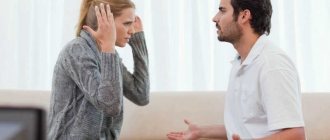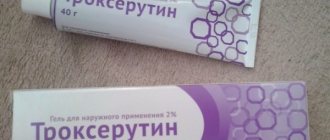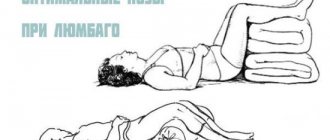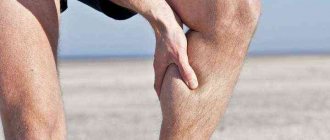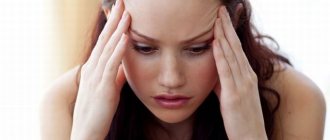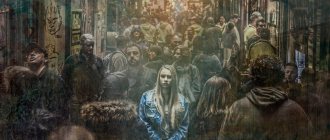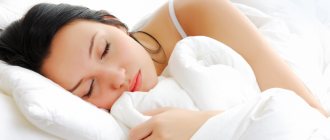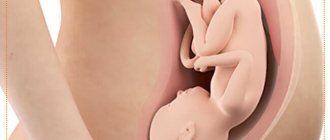Clinical picture
When the neck is pinched, the pain can radiate to the head, shoulders, and arms
The cervical vertebrae and muscles are relatively small in size, so they react more quickly to various adverse influences from the outside. This section of the spine is considered the weakest.
Jamming usually occurs abruptly, for example, after turning the head. The muscles spasm. The more serious the cause, the more extensive the pain. They can be transmitted to nearby structures - shoulders, lower neck muscles, collarbones, and back of the head.
If the nerve roots are affected, your hands or fingertips may become numb, depending on the vertebra at which the jamming occurred. The higher the vertebra is located, the greater the likelihood of dizziness or headaches, since the vertebral arteries can be pinched due to muscle spasm.
Symptoms
The severity of the manifestations of pinching directly depends on which part of the nerve cord of the facial nerve has undergone pathological changes.
There are early signs that appear even before the main symptoms become noticeable. They are expressed in the form of painful sensations in the parotid area. In the future, symptoms manifest themselves rapidly with pronounced signs:
- partial or complete violation of facial expressions;
- lowering the corner of the mouth, smoothing the nasolabial fold on the right or left side;
- pronounced facial symmetry;
- drooping lower lip;
- inability to completely close the eye;
- bulging of the eyeball with upward displacement;
- impaired ability to move the eyeball;
- lack of conjunctival reflex (quick closing of the eye when touching the eyeball);
- change in taste sensations;
- impaired salivation (increased saliva volume or dry mouth);
- dry eyes or increased tear production;
- temporary hearing loss or painful reaction to loud sounds;
- impaired sensitivity of facial skin;
- inability to form lips into a tube.
A sufficient reason to consult a doctor may be a person’s inability to perform the following actions:
- whistling;
- blowing out a candle or match;
- forehead wrinkling;
- complete closure of the eyes;
- alternate blinking of the right and left eyes;
- wrinkling of the nose or frowning of the eyebrows;
- holding a sip of water in your mouth.
The speed of going to the hospital after the onset of symptoms directly affects the success of treatment and reduces the likelihood of complications.
We invite you to watch a video that talks in detail about peripheral paresis (Bell's palsy).
Causes of sudden neck jamming
Degenerative diseases of the spine lead to pinched nerve roots
Nerve root entrapment occurs for the following reasons:
- Osteochondrosis is a degenerative disease of the spine, in which the height of the spinal disc decreases, the bony vertebrae are displaced, and the clearance for the nerve becomes smaller. Spondylosis is characterized by similar manifestations, but in this case, the cause of the infringement is osteophytes - bone growths on the edges of the vertebrae.
- Spondylolisthesis is a displacement of the vertebrae relative to each other. This happens in the cervical region more often than in any other region, since the muscles in this area are weaker and cannot hold the spine in the correct physiological position.
- Arthritis - can be of an autoimmune nature, as a result of which pinching of nerve processes occurs frequently - during an exacerbation of the disease. Inflammation is transmitted to surrounding tissues - muscles and nerves.
- Injury to the cervical spine - can be expressed in short-term excess loads on the neck area. The ligaments become overstretched and the area becomes temporarily unstable. Any awkward movement can cause jamming.
- Colds or exposure to drafts. People especially often suffer in the summer, when after a hot day they find themselves in a room with a running air conditioner. A sharp change in temperature has a negative effect on muscles. When hypothermia or severe inflammation in the larynx occurs, the process spreads to nearby spinal structures, causing them to spasm.
- A protrusion or hernia of the cervical spine can also be asymptomatic and manifest itself with rare pain in the neck or back of the head. The sooner a person learns about the existing pathology, the greater the chance of a complete cure and the cheaper it will cost.
- In people whose work involves sitting at a computer for long periods of time, the neck muscles are very weak, and static tension contributes to swelling, after which the person may feel sudden pain on the right or left. The same thing can happen after sleep, when the neck muscles were in an awkward position and were tense.
In children, problems with turning the head and neck pain are often associated with physical overload, for example, after working out in the gym. Children have poor control over the load, so the muscles can respond with soreness to exceeding the body's capabilities. The reason for this is the concentration of lactic acid in muscle tissue.
Causes of discomfort in osteochondrosis
It is wrong to attribute pain and discomfort in the throat only to cervical osteochondrosis. The causes of unpleasant long-term phenomena, in addition to cervical osteochondrosis, are:
- suffered severe stress, depression;
- disorders of the thyroid gland;
- diseases of the gastrointestinal tract;
- consequences of a cold.
It will not be possible to independently determine the cause of the unpleasant phenomenon; you should consult a doctor, who, after conducting diagnostics, will make an accurate diagnosis and prescribe treatment.
If the doctor has diagnosed cervical osteochondrosis, sore throat, discomfort arises due to displacement of the intervertebral discs, inflammatory process in the discs. Leads to complications that negatively affect the nerve roots of the discs and the peripheral part of the nervous system. This is where a sore throat with osteochondrosis, a sensation of a lump, a feeling of constriction, or the presence of a foreign object in the throat originate.
Cervical osteochondrosis is often accompanied not only by unpleasant sensations. Mobility in the neck area is often limited. When cervical osteochondrosis occurs, the throat hurts, sharp, piercing pain occurs when trying to turn the head, there is numbness in the arms, pain in the shoulder, forearm, it is impossible to touch the neck, pain radiates to the elbow joint, fingers, external pain sensitivity of the shoulder and forearm is reduced.
Diagnostic methods
The first stage of diagnosis is history taking, examination and palpation
To stop worrying unnecessarily, it is recommended to visit a doctor and get examined. This is a positive decision for several reasons:
- Make sure that everything is in order with the tissues of the spine, because osteochondrosis begins unnoticed. People turn to doctors when the disease can no longer be cured by simple methods, such as gymnastics and physiotherapy.
- Eliminate the risk of injury if jamming occurs during training and the person plays sports professionally. An old, untreated injury can make itself felt over time, at the most unfavorable moment.
- Examine muscle tissue to see if there is chronic myositis. This is a disease in which lumps form in the muscles. Under unfavorable circumstances, a purulent abscess may develop at the site of the nodule, which will require urgent surgical intervention.
- Examine the vertebral and carotid arteries for the presence of pathological tortuosity, which may be congenital and not pose a danger until a certain point, and then manifest itself in the form of transient ischemic attacks. The worst case scenario for this problem is a stroke. About 80% of people who survived an ischemic stroke had problems with blood vessels, but were not aware of them.
Diagnostic measures include:
- Conversation with the patient - when and why, in his opinion, the jamming occurred.
- Inspection and palpation of the painful area.
- Ultrasound examination of muscles.
- Doppler examination of the vessels of the neck for the presence of cholesterol plaques - this applies more to older people.
- X-ray of the neck - allows you to detect curvature in the cervical spine, displacement of the vertebrae, protrusion or hernia.
If necessary, the doctor may recommend a CT or MRI to obtain layer-by-layer sections of soft and hard tissues. Imaging is indicated for suspected tumors or other serious diseases that are best treated at an early stage.
Can a pinched cervical nerve cause headaches?
Unfortunately, this is a fairly common occurrence when pinched. If signs of cervical radicolopathy are combined with symptoms of poor blood supply to the brain, immediately consult a doctor or call an ambulance.
- You are suffering from migraine-like headaches.
- Your blood pressure is going up.
- Sudden movements cause pain and dizziness.
- There is a noise in my ears.
- You began to hear poorly, and spots appeared in your eyes.
- Severe weakness and fatigue. You have trouble with your usual actions and mental operations.
- Memory has deteriorated sharply.
Do not hesitate to visit a doctor under any circumstances! This condition can cause a stroke!
First aid
In the event of a sharp pinching, the affected area must be immobilized.
If your neck suddenly jams and it hurts to turn your head in any direction, the first thing to do is try not to disturb the affected area. If possible, you should lie down, using a towel to support the muscles - throw it over your neck, and pull the ends forward with your hands. This helps to avoid sharp pain and lumbago when tense. The towel can be wrapped around the neck so as not to accidentally jerk the neck and provoke a lumbago - this is an analogue of the Shants collar, which limits movements and turns of the head.
It is recommended to immediately drink some painkiller so that the spasms go away. You cannot start doing exercises to unblock the cervical spine - this can worsen the situation and the pain will last longer. If your shoulders do not hurt, it is recommended to raise and lower them several times to improve blood circulation in the affected area. In most cases, even this simple exercise causes discomfort.
Ice can be used if it is known for sure that the cause of the neck jam is not hypothermia or exposure to a draft. In this case, it is better to use dry heat, for example, coarse sea salt heated in a frying pan or a hot water bottle wrapped in a cloth.
You can ask someone close to you to do a light neck massage - lymphatic drainage. This helps relieve swelling. The movements of the massage therapist's hands should be directed from top to bottom, otherwise the pain will intensify due to the accumulation of lymph and spasm of the lymphatic vessels due to muscle swelling.
Ways to relieve pain and relieve inflammation
The doctor must select a specific ointment
Medication can help a person cope with the situation by taking medications:
- Anti-inflammatory non-steroidal drugs - Ibuprofen, Diclofenac, Paracetamol. Their effect lasts 3–4 hours, then you need to take the next dose. People with gastrointestinal problems are recommended to use analogues in the form of rectal suppositories or injections.
- Steroid hormones are prescribed only by a doctor and in a strictly defined dosage. This group of drugs has many contraindications and side effects and is used for inflammation of autoimmune origin.
- Muscle relaxants are drugs that have a relaxing effect. Used in case of muscle spasm to relieve compression of blood vessels and improve blood circulation.
- Ointments - anti-inflammatory or warming - can be used from the first day of treatment. The most effective ones are based on bee or snake venom.
- Blood thinners help increase blood circulation in the inflamed area, thereby removing toxic substances from the soft tissues more quickly. The most common drug is aspirin.
Novocaine blockade is a procedure that is carried out only in a medical institution. Anesthetic injections are given in the neck to relieve severe pain. The blockade is used when nerve roots are pinched by a damaged cartilage disc or hernia at the time of exacerbation.
Physiotherapy
If a person is undergoing treatment under the supervision of a doctor, he may be prescribed magnetic therapy, electrophoresis or UHF for deep heating of the neck muscles. After a course of physiotherapy, lasting relief occurs even with degenerative processes in the spine.
Alternative medicine
Acupuncture in the neck to relieve inflammation and pain
Supporters of alternative methods of treatment can resort to the help of a hirudotherapist. The principle of action of leeches is to remove toxic blood from the affected area, relieve swelling, inflammation and pain.
Acupuncture is performed at specific points on the body. The effect may occur after the first session.
ethnoscience
Most people prefer to be treated at home, as weakness and pain prevent them from moving freely.
Recipes for relieving neck pain:
- Ointments based on medicinal herbs. At the time of pain, a person does not have a ready-made medicine, so it takes time to prepare it. You can buy hot mustard in the store and apply it to the skin for 10 - 15 minutes, covering it with a cloth, then rinse with water.
- Alcohol-based rubs promote deep warming of the entire shoulder girdle, but their preparation requires time - at least a week - for the active substances from the herbs to transfer into alcohol.
- Teas and decoctions of anti-inflammatory herbs are the easiest to make. Chamomile, sage, thyme, and ginseng are suitable. If you have aloe at home, it is recommended to chew it raw, since the plant contains many substances and microelements that have a positive effect on human immunity. The advantage is that it simultaneously eliminates dehydration and increases metabolism throughout the body.
- Compresses – promote the penetration of active substances from herbs through the skin to the spinal discs, muscles and bones. It is recommended to use at night in parallel with medications - this will speed up recovery. Salt lotions are quickly made - 3 tablespoons of salt per liter of water. The pain goes away after the first application. The compress should not be covered with plastic wrap.
If a nerve is pinched in the neck, rubbing and compresses are ineffective, because first it is necessary to unblock the nerve root, and then eliminate swelling and inflammation.
Neuralgia of the glossopharyngeal nerve
Signs
Most often, this disease develops at the age of 30-40, and in women twice as often as in men.
They complain of paroxysmal pain in the area of the root of the tongue or tonsil, radiating to the palate, throat, ear, angle of the lower jaw, and the side of the neck. In this case, profuse salivation, facial redness, cough, syncope with decreased blood pressure, weakened pulse, muscle weakness, and even fainting often occur. The pain is usually paroxysmal, lasting about two minutes, varying in intensity: from single, weakly noticeable pain to unbearable paroxysmal shooting pains. Sometimes patients discover an area that is the source of pain; touching it causes an attack. It can be located in the area of the root of the tongue, tonsil, and sometimes outside the innervation of the glossopharyngeal nerve (on the chin, earlobe, etc.). Painful attacks are provoked by swallowing food or saliva, or talking. This disease is characterized by periods of exacerbation, most often in autumn-winter, and remission, when there is practically no pain.
Symptoms by which the diagnosis of “neuralgia of the glossopharyngeal nerve” is established: the presence of a zone of innervation of the glossopharyngeal nerve (localization of pain), paroxysmal nature of pain, irradiation of pain in different zones, the presence of accompanying symptoms and a pain point behind the angle of the lower jaw. Bitter food is a provocateur of attacks.
Description
Neuralgia of the glossopharyngeal nerve can be caused by diseases of the ear, nose and throat, compression of the nerve by the muscles under the base of the skull. Once the location (cause) of compression (irritation) of the glossopharyngeal nerve is discovered, neuralgia can be successfully treated, albeit for quite a long time. Sometimes it lasts up to two years.
The cause of the development of the disease can also be infections (chronic tonsillitis, tonsillitis, influenza), intoxication (tetraethyl lead poisoning). Glossopharyngeal neuralgia syndrome occurs as a result of trauma to the tonsil bed by an excessively elongated styloid process, as well as ossification of the stylohyoid ligament, tumors of the cerebellopontine angle, carotid artery aneurysm, laryngeal cancer, etc. There is evidence that oncological diseases of the pharynx or larynx may be reported for the first time about myself with neuralgic pain syndrome in this area.
Diagnostics
To establish a diagnosis of glossopharyngeal neuralgia, you should carefully consider the symptoms and carry out a differential diagnosis with trigeminal neuralgia. The main difference between these diseases is the localization of pain and the age of the patients, as well as the different location of trigger zones: with trigeminal neuralgia they are located on the face, often around the lips, and with glossopharyngeal neuralgia they are located at the root of the tongue.
A comprehensive examination of those suffering from neuralgia includes an orthopantomogram, which allows one to determine the presence or absence of an enlargement of the styloid process or ossification of the stylohyoid ligament, computed tomography (CT) of the brain or magnetic resonance imaging (MRI) of blood vessels, which can be used to identify compression of the nerve root by a vessel or other structures. A consultation with an oncologist is required to rule out cancer.
Treatment
Neuralgia of the glossopharyngeal nerve, like trigeminal neuralgia, is treated conservatively with medications as prescribed by a doctor. General restoratives are also recommended: vitamins, aloe extract, FiBS, ATP, phytin, ginseng, etc. If the disease is not advanced, then physiotherapy helps. In addition, since in this disease the causes of compression (compression of the nerve roots) are more often identified, it is easier for those suffering from neuralgia of the glossopharyngeal nerve to be helped using surgical methods, for example, by resection of the enlarged styloid process.
© Dr. Peter
Preventive actions
People suffering from degenerative diseases of cartilage and bone tissue are advised to follow a diet high in calcium. It is believed that food clay - white, blue or green - contains almost all the microelements for the normal functioning of the body and all its systems.
Gymnastics is the best cure for all problems with the spine, especially its most mobile parts - the cervical and lumbar. By devoting 30 minutes a day to warming up and pumping up your muscles, you can avoid age-related pain and maintain the health of your internal organs.


